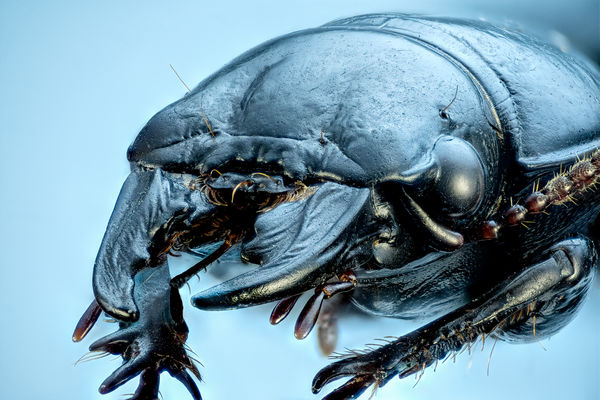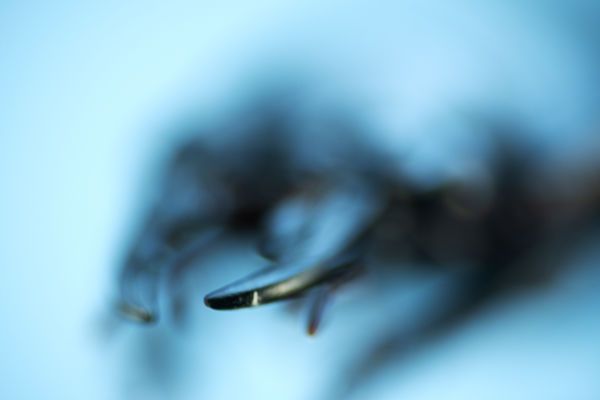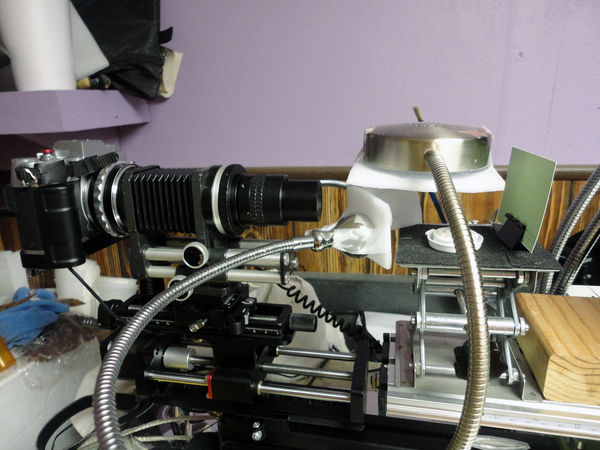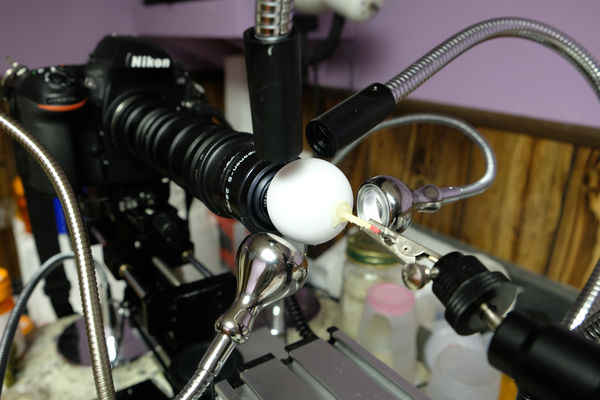Beetle With Large Mandibles
Oct 19, 2020 20:33:11 #
This is one of my many preserved beetles which has very powerful mandibles used for munching pieces of rotting wood.
It is a focus stacked image taken at 5X magnification using a microscope objective attached to a bellows as the lens of the camera.
For those that are interested in knowing a bit more, here's some technical information about setup and process:
The first image is processed from the stack of 327 individual images. The second image is one of those that shows just how shallow each one is and that there is never a fully focused subject. This is due to the physical charistic of a microscope objective related to its "Numerical Aperture" which determines its 'depth of field' which is similar to an f-stop yet different in its own way and microscope objectives are viewed 'wide open' although there are very special exceptions.
This 5X magnification power objective has an "NA" of 0.13. The formula that is used to determine the Depth of Field in millimeters is D.O.F. = 0.00055/(NA*NA) or in my case D.O.F. = 0.00055/(0.13*0.13) = 0.0325mm or 32/1000 of a millimeter.
This is why it takes so many steps to go from a point where the closest point of a subject is in focus to the farthest point wanted of the subject in focus. For this image the camera moved a total distance of 10.6mm taking a picture every 0.0325mm along its way.
With such small increments of movement and the need to be consistent with each step it requires the use of a digital motorized focus rail controlled by a computer although operating a focus rail manually is done quite often by many and it is how I got started.
Another aspect of using a microscope objective is the "Working Distance". This is essentially how far the tip of the microscope objective is from touching the subject. If we think about the images that we see of those using a microscope in a lab we can envision just how close the objective is to the glass slide.
A longer working distance favors lighting the subject and illumination is an art and science in itself as well as a topic for another day. For those who may have an interest in using microscope objectives be sure to understand what the working distance is of the objective that you are looking at before you purchase one. I bought a 40X objective that has a working distance of 0.7mm which made it a useless investment for micro photography although it does make an interesting paperweight.
The one that I most often use is pictured above and it has a listed working distance of 64mm which is considered miles compared to most others which makes getting diffused light on the subject that close to the lens to be a real trick which is why I place the subject inside of a ping-pong ball when using my objectives that have a very small working distances of several millimeters.
It is a focus stacked image taken at 5X magnification using a microscope objective attached to a bellows as the lens of the camera.
For those that are interested in knowing a bit more, here's some technical information about setup and process:
The first image is processed from the stack of 327 individual images. The second image is one of those that shows just how shallow each one is and that there is never a fully focused subject. This is due to the physical charistic of a microscope objective related to its "Numerical Aperture" which determines its 'depth of field' which is similar to an f-stop yet different in its own way and microscope objectives are viewed 'wide open' although there are very special exceptions.
This 5X magnification power objective has an "NA" of 0.13. The formula that is used to determine the Depth of Field in millimeters is D.O.F. = 0.00055/(NA*NA) or in my case D.O.F. = 0.00055/(0.13*0.13) = 0.0325mm or 32/1000 of a millimeter.
This is why it takes so many steps to go from a point where the closest point of a subject is in focus to the farthest point wanted of the subject in focus. For this image the camera moved a total distance of 10.6mm taking a picture every 0.0325mm along its way.
With such small increments of movement and the need to be consistent with each step it requires the use of a digital motorized focus rail controlled by a computer although operating a focus rail manually is done quite often by many and it is how I got started.
Another aspect of using a microscope objective is the "Working Distance". This is essentially how far the tip of the microscope objective is from touching the subject. If we think about the images that we see of those using a microscope in a lab we can envision just how close the objective is to the glass slide.
A longer working distance favors lighting the subject and illumination is an art and science in itself as well as a topic for another day. For those who may have an interest in using microscope objectives be sure to understand what the working distance is of the objective that you are looking at before you purchase one. I bought a 40X objective that has a working distance of 0.7mm which made it a useless investment for micro photography although it does make an interesting paperweight.
The one that I most often use is pictured above and it has a listed working distance of 64mm which is considered miles compared to most others which makes getting diffused light on the subject that close to the lens to be a real trick which is why I place the subject inside of a ping-pong ball when using my objectives that have a very small working distances of several millimeters.
Oct 20, 2020 20:42:38 #
sippyjug104 wrote:
This is one of my many preserved beetles which has... (show quote)
Beautiful images, Sippy, and thank you for sharing your impressive technique and setup!!
Oct 20, 2020 20:55:50 #
Dixiegirl wrote:
Beautiful images, Sippy, and thank you for sharing your impressive technique and setup!!
Thanks, Donna. I'm sure that it is much more than most care to know however I've been asked a few times how it is that I do my sessions so I thought it would be nice to share.
Oct 20, 2020 21:16:25 #
sippyjug104 wrote:
Thanks, Donna. I'm sure that it is much more than most care to know however I've been asked a few times how it is that I do my sessions so I thought it would be nice to share.
Most grateful for your taking the time to share, Sippy.
Oct 24, 2020 12:36:49 #
Hi Sippy. I added a link for this thread in the Tutorials and Tips doc:
https://www.uglyhedgehog.com/t-645057-1.html
I wasn't sure how to title it, so I wrote "Focus stacking with microscope objective." I'd be happy to change that if there's a better way
https://www.uglyhedgehog.com/t-645057-1.html
I wasn't sure how to title it, so I wrote "Focus stacking with microscope objective." I'd be happy to change that if there's a better way

Oct 24, 2020 12:53:05 #
Linda From Maine wrote:
Hi Sippy. I added a link for this thread in the Tutorials and Tips doc:
https://www.uglyhedgehog.com/t-645057-1.html
I wasn't sure how to title it, so I wrote "Focus stacking with microscope objective." I'd be happy to change that if there's a better way
https://www.uglyhedgehog.com/t-645057-1.html
I wasn't sure how to title it, so I wrote "Focus stacking with microscope objective." I'd be happy to change that if there's a better way

Thanks ever so much, Linda. It would be a great pleasure to share what I do and how I do it to aid others that may wish to venture into the realm of extreme macro focus stacking.
If you want to reply, then register here. Registration is free and your account is created instantly, so you can post right away.






